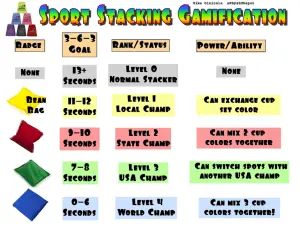What is it?
Gamification has been in education news for several years now. It’s often misunderstood, with people believing it’s about playing video games, which causes some teachers to shy away. However, gamification is not playing video games, but instead taking the psychology and mechanics that developers use to make them so darn entertaining and addictive to both kids and adults and applying those ingredients to either business or education. This greatly increases motivation and engagement while reducing classroom behavior issues. The best part is how simple it is to add gamification in PE. Easily introduce them to your lessons and activities! In fact, many folks do it naturally without even realizing it!
Physical education is game-based learning, which is fun for most students, but it differs naturally from gamification. Classroom teachers allowing student to play game software to learn is also game-based learning. By using gamification in lessons, we draw in more at-risk learners who typically give lower effort.
Is it hard to implement?
Gamification can be as deep or shallow as we want it to be. It can be part of a single activity, a whole lesson, a unit, or even a full-year theme (like superheroes, world travel, secret agents, sci-fi, etc) using spread sheets or software like Classcraft to track all the data.

Here’s a basic sample for a sport stacking activity (which can be written on a white board without the extra art) activity:
The basic idea is to give kids attainable mini-goals or challenges, with frequent feedback and ranks or achievement levels. The badge or indicator of rank or status can be anything, even just a piece of paper (or nothing at all) or play money they turn in at the end of class. An earned privilege or power also helps with the motivation (maybe changing the class music, switching places with someone to get closer to the teacher or a friend, etc), though it’s best to stick with non-tangible rewards instead of stickers and other physical gifts. This helps keep the content more in line with intrinsic motivation and less on extrinsic, though almost any given reward will, at its core, be an external motivator. The thing to remember is that both motivation types are always simultaneously present in anything we do, even as adults. We just want to balance it as close to internal as possible.
The next sample idea came from a friend of mine, Ryan Armstrong. He tied jump rope achievement to martial arts belts in something known as “ninja belt jump rope.” Students keep track of their levels with either Post-It notes, Plickers magnets or even laminated belts on paper. The best way to do it is to offer choice, a strong motivator for students.

They can get to each belt in one of three ways: Do X number of consecutive jumps, or less trick jumps since they’re harder, or for lesser skilled students they can do more overall, but it doesn’t have to be consecutive, allowing for mistakes. This meets the needs of all learners and keeps them all engaged since they can find some success regardless of their abilities.
Summary
If you want to create lessons that are engaging for students, consider adding gamification elements so that students feel the learning is like being inside a video game world. Gamification in PE is easy to implement, can make teaching way more fun, and greatly improves classroom management and reduces behavior issues. I urge you to try it during a lesson next year!
Resources
- My website gamification page, with videos, info, samples and links to resources
- This is a great book to help educators get started.
- The shared global PE Google Drive gamification folder.





2 Responses
I like the idea of including gamification in my PE lesson.
Thank Niki
Gamification is a great idea to keep the kids motivated.